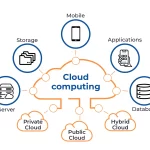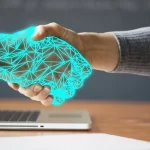What is Cloud Computing How does it work
In today’s digital age, the term “cloud computing” has become increasingly prevalent. Whether you are a business owner, a technology enthusiast, or simply an avid internet user, understanding the concept of cloud computing is essential. This revolutionary technology has transformed the way we store, access, and manage data. In this blog post, we will delve into the world of cloud computing, exploring its definition, key components, and how it works.
Defining Cloud Computing: At its core, cloud computing refers to the delivery of computing services over the internet. Instead of relying on local servers or personal computers, users can access and utilize resources and applications hosted on remote servers, commonly referred to as the “cloud.” These resources include storage, databases, software, and processing power.
Key Components of Cloud Computing: Cloud computing consists of several essential components that work in harmony to provide its multitude of services. Let’s explore the key components:
- Infrastructure as a Service (IaaS): This component provides virtualized computing resources, such as virtual machines, storage, and networks, delivered over the internet. Users can scale resources up or down based on their requirements without the need for physical infrastructure.
- Platform as a Service (PaaS): PaaS offers a platform that enables developers to build, test, and deploy applications without worrying about the underlying infrastructure. It provides a complete development and deployment environment, including operating systems, databases, and web servers.
- Software as a Service (SaaS): SaaS delivers software applications over the internet, accessible through a web browser. Users can access and utilize these applications without the need for installation or maintenance. Examples of SaaS include customer relationship management (CRM) systems and productivity tools like Google Workspace.
- Public, Private, and Hybrid Clouds: Cloud computing services can be categorized into different types based on their accessibility and ownership. Public clouds are accessible to the general public, while private clouds are dedicated to a single organization. Hybrid clouds combine elements of both public and private clouds, allowing organizations to leverage the benefits of both models.
How Does Cloud Computing Work? Now that we have a foundational understanding of cloud computing’s components, let’s explore how it works:
- Virtualization: Virtualization is a fundamental aspect of cloud computing. It involves creating virtual instances of servers, storage, and other resources. Virtualization allows multiple users to share physical resources while maintaining isolation and security. This enables efficient resource utilization and scalability.
- Resource Pooling: Cloud service providers pool their computing resources to serve multiple customers simultaneously. Through resource pooling, providers can achieve economies of scale and offer resources on-demand. Users can access these resources through an internet connection, irrespective of their physical location.
- Elasticity and Scalability: One of the most significant advantages of cloud computing is its ability to scale resources on-demand. Users can quickly scale up or down their resource allocation based on their needs, ensuring optimal performance and cost-effectiveness. This elasticity enables businesses to respond to fluctuations in demand efficiently.
- Data Storage and Accessibility: Cloud computing providers offer secure and reliable data storage solutions. Users can store their data in the cloud, accessing it from anywhere with an internet connection. Cloud storage offers features such as data redundancy, backup, and disaster recovery, ensuring data integrity and availability.
- Security and Privacy: Cloud computing providers employ advanced security measures to protect user data. These include encryption, authentication, and access controls. Additionally, cloud providers adhere to industry-standard security certifications and compliance regulations to ensure the privacy and confidentiality of user information.


































